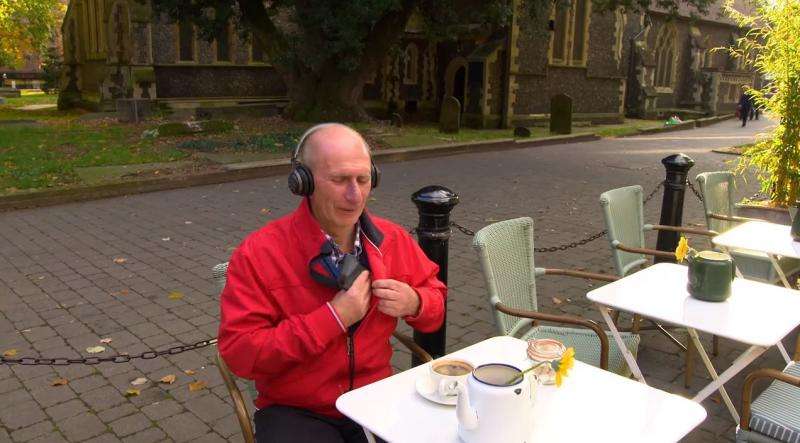December 2, 2015 weblog
Headphones, buttons, app all work toward freedom for blind city dwellers

A leisurely day spent window shopping, and browsing in shops and discovering new places, things we enjoy but take for granted as part of town and city life. For the blind, such activities might be considered out of the realm of possibilities. Getting to a predetermined Point B from Point A is challenge enough.
Microsoft's engineers, though, are asking, why not? What kind of solution could free the blind to try out new cafes or maneuver in streets they have never visited before?
A collaboration between Microsoft, Guide Dogs and the urban innovation center, Future Cities Catapult, has been under way to help people with sight loss to get about easier. The project is Cities Unlocked and its leaders recently released an update to tell the world how they are doing.
The Cities Unlocked team said, "We believe that technology can open up our cities and reduce the stress associated with getting around urban spaces."
What is the update all about? The technology update offers more mobility, simply speaking. The Irish Examiner recalled the first prototype of the technology that had been unveiled previously, as using clicking sounds to guide people in the correct direction.
There has been a redesign; the hardware and software combination provide a more "descriptive" rather than "prescriptive" user experience. Components of the new solution are headset with physical remote—to keep hands free, easy for those using a cane or a dog—and software.
Buttons enable the user to get information about compass direction, or a repeat of the last piece of information, or to tell the person what is in the immediate surroundings, or to impart more details about those surroundings.
This is the technology at its next level, the ability to orientate the person at any site whether indoors or outdoors.
James Titcomb in The Telegraph wrote about the significance of this next-phase step for someone who cannot see, who has depended on canes, dogs and another person arm in arm. Fundamentally, the new technology has been designed to set them free to explore and discover. Now people who have difficulty seeing can actually try out something new—a cafe, a street, or any other destination of interest.
The first phase was designed to let people find the way from A to B but the second phase is more focused on telling users where they are, rather than directing them on how to get somewhere.
The information sparks curiosity. Trialist Gerald James said the device does paint a picture of the town. "It told me all the different shops on the side of the road. It also told me the names of the streets."
Navigation is enabled with sound. The Irish Examiner said that users were "now able to use either their voice or a remote to ask for and hear additional information about their surroundings. This works alongside the navigation within the app that guides wearers to and around a destination using directional audio and sound prompts to help build a mental image."
Microsoft refers to the 3D audio experience – creating a map of what's around you based on the sound you hear and where it comes from.—irish excaminer
The Telegraph said the team is making use of Microsoft's Bing Maps, as well as work with CityScribe. The latter is a crowdsourced mapping service where users get to tag obstacles— benches, bins and scaffolding, for example.
James Farrell in SiliconANGLE similarly reported that "The improved device, that fits to the ears, can now understand voice commands that might be used to ask for further information or to replay audio that the user has just heard. You can also now tag obstacles that have gotten in your way, using the app CityScribe."
While GPS is in use for outdoors, Bluetooth beacons are used indoors, such as in malls.
Titcomb of The Telegraph, as a stranger in the town of Reading, was blindfolded and delivered this feedback in a test of the Cities Unlocked project's phase-two technology: "On a busy street in Reading, I was given a special pair of over-ear headphones developed by hearing aid company GN Store Nord with a built-in accelerometer, gyrometer, compass and speakers in different parts of the headphones.
"This headset essentially became my anchor as I awkwardly made my way around Reading. Combined with Soundscape, Microsoft's app on my smartphone, it knew which way I was facing, where I was, and what way I needed to go to get somewhere."
He also wrote:
"Deprived of my sight, I interacted with the technology via a three-button Bluetooth remote around my neck. Pressing one button triggered 'orientate' mode, which would allow me to figure out where I was by distance to various landmarks. 'WHSmith, 35 meters' my special headphones said, with the sound coming from a speaker to the front of my right headphone - the direction the building was. 'John Lewis Broad Street Entrance, 25 meters,' came the voice from behind my left ear. 'Bicycle racks, five meters,' from my right."
Cities Unlocked, according to Irish Examiner, said research had found that around 180,000 registered blind people in the UK were not confident enough to leave their homes alone. But research conducted by Microsoft's partnership after their initial trial found that 62 percent of participants had an increased feeling of safety and confidence.
As for future work, more testing will be involved before the technology makes it into the public's hands, said The Telegraph.
© 2015 Tech Xplore


















